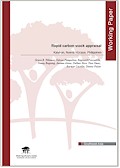| Working Paper Series |
 |
|
| Title | Rapid Carbon Stock Appraisal: Kalahan, Nueva Vizcaya, Philippines | | Author | Grace B.Villamor, Nelson Pampolina, Reginald Forcadilla, Nonoy Bugtong, Jerome Alano, Delbert Rice, Tina Omas, Reymar Castillo and Dennis Pulan | | Year | 2010 | | Publisher | World Agroforestry Centre - ICRAF, SEA Regional Office | | City of Publication | Bogor, Indonesia | | Series Number | Working paper nr 106 | | Number of Pages | 87 | | Call Number | WP0156-11 | | Keywords | carbon stock assessment, farming practices, Ikalahan Ancestral Domain, land-use change |
|
| Abstract: |
A research method called Rapid Carbon Stock Appraisal (RaCSA) was conducted in Kalahan Forest Reserve (KFR), in Nueva Vizcaya Province, Northern Luzon, Philippines from August 2009 to January 2010. The aim of this activity was to support communities, such as the Ikalahan people, to establish basic data needed in negotiating with carbon markets in a costeffective and time-efficient manner. The appraisal involved a combination of methods and activities (for example, plot-level carbon measurement, spatial analysis of land-use cover, focus group discussions, key informant interviews and a review of the literature).
There were several key results of the appraisal.
• Land-use types and farming practices. The majority of Ikalahan are swidden farmers practising traditional farming (for example, pang-omis, which involves integrating tree seedlings of species such as Alnus in the swidden farms). Five major land-use and land-cover types were identified and assessed, that is, agriculture, agroforest, grassland, reforestation and secondary forests.
• Plot-level carbon stocks. The estimated carbon stock of land-use systems in the KFR ranged 0.61–77.86 Mg/ha for aboveground carbon; and 21.8–67.4 Mg/ha for
belowground. Total (above- and belowground) carbon stock was estimated to range
54.31–151.13 Mg/ha. These results are low compared to other carbon assessments
conducted in the country.
• Land-use and land-cover changes. Land-use and land-cover changes within KFR between 1981 and 2001 were assessed. A decrease in forest, pine and agriculture
occurred while there was an increase in old pine and reforestation (for example,
mahogany). Carbon values from monitoring plots in 1994 and 2003 were used to
extrapolate the land-cover types of the 1981 and 2001 maps, respectively. Based on
the results, total carbon stock was approximately 375.8 Gg in 1994 and 452.1 Gg in
2003, that is, a 21% increase in 12 years.
• Carbon emissions. From the land-cover changes, we estimated that the KFR
sequestered carbon annually at an average of 0.5 Gg and that 1.4 Gg of carbon was
emitted each year over the period 1989 to 2001.
• The Kalahan Educational Foundation is the major stakeholder in the KFR. It has
established its own rules and regulations related to natural resources development
and has supported traditional farming practices and management strategies (for
example, their ‘forest improvement technology’) to enhance the carbon stock within
the KFR. Currently, the Foundation is exploring the Clean Development Mechanism
market. Future options and their implications for the KFR are included in the paper. |
|